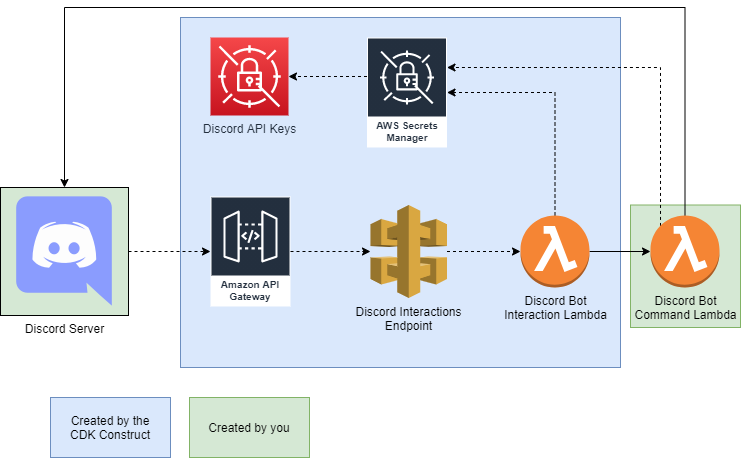discord-bot-cdk-construct
v0.3.5
Published
A quick CDK Construct for creating a serverless Discord bot in AWS!
Downloads
542
Maintainers
Readme
discord-bot-cdk-construct
A CDK Construct for creating a serverless Discord bot. All you need to do is supply your code to handle the commands!
Architecture Overview
This is the architecture for how this project is laid out server-side. The tools used to create these diagrams are:
The bot has a fairly straightforward setup:

The biggest confusion likely stems from the use of two Lambda functions instead of one. This is to ensure that the initial request can respond within Discord's 3 second time limit and return a proper response to the user.
Sample Usage
The usage is split into two parts: The AWS CDK stack that will be used, and a "commands" script that actually handles responding. It's recommended that you are familiar with CDK first before diving into using this.
Handling Commands
For handling commands, you just need to provide a Lambda function for sending response to Discord's Web APIs. As an example of how this can be done:
import {Context, Callback} from 'aws-lambda';
import { IDiscordEventRequest, IDiscordResponseData, getDiscordSecrets, sendFollowupMessage } from 'discord-bot-cdk-construct';
export async function handler(event: IDiscordEventRequest, context: Context,
callback: Callback): Promise<string> {
const discordSecret = await getDiscordSecrets();
const endpointInfo = {
authToken: discordSecret?.authToken,
applicationId: discordSecret?.applicationId
};
const response = {
tts: false,
content: 'Hello world!',
embeds: [],
allowedMentions: [],
};
if (event.jsonBody.token && await sendFollowupMessage(endpointInfo, event.jsonBody.token, response)) {
console.log('Responded successfully!');
} else {
console.log('Failed to send response!');
}
return '200';
}Using the Construct
To create a stack to make use of the above script, you can create a stack like so:
import {Duration, Stack} from 'aws-cdk-lib';
import {Runtime} from 'aws-cdk-lib/aws-lambda';
import {NodejsFunction} from 'aws-cdk-lib/aws-lambda-nodejs';
import {DiscordBotConstruct} from 'discord-bot-cdk-construct';
import {Construct} from 'constructs';
import * as path from 'path';
/**
* Creates a sample Discord bot endpoint that can be used.
*/
export class SampleDiscordBotStack extends Stack {
/**
* The constructor for building the stack.
* @param {Construct} scope The Construct scope to create the stack in.
* @param {string} id The ID of the stack to use.
*/
constructor(scope: Construct, id: string) {
super(scope, id);
// Create the Commands Lambda.
const discordCommandsLambda = new NodejsFunction(this, 'discord-commands-lambda', {
runtime: Runtime.NODEJS_18_X,
entry: path.join(__dirname, '../functions/DiscordCommands.ts'),
handler: 'handler',
timeout: Duration.seconds(60),
});
const discordBot = new DiscordBotConstruct(this, 'discord-bot-endpoint', {
commandsLambdaFunction: discordCommandsLambda,
});
}
}This can of course then be used in your CDK application like so:
import { App } from 'aws-cdk-lib';
import { SampleDiscordBotStack } from './stacks/sample-discord-bot-stack';
const app = new App();
const startAPIStack = new SampleDiscordBotStack(app, 'SampleDiscordBotStack');Full Demo Project
A full example project utilzing this construct can be found here. Specifically, the start-api-stack.ts file uses the construct, with DiscordCommands.ts being the commands file (like shown above).
Packaging with JSII
In order to package everything with JSII, ensure you have the following installed:
- Python3
- Open JDK
- Maven
See JSII's Prerequisites Documentation for more information.
Useful commands
npm run buildcompile typescript to jsnpm run watchwatch for changes and compilenpm run testperform the jest unit testsnpm run lintperform a lint check across the codenpm run fix-lintfix any lint issues automatically where possiblenpm run packagepackage all of the bindings for distribution


